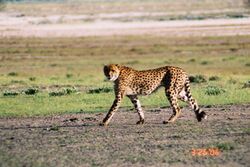Acinonyx jubatus (Cheetah): Difference between revisions
imported>Brian F. Kuhn (New page: {{subpages}} {{Taxobox | color = pink | name = Cheetah | regnum = Animalia | phylum = Chordata | classis = Mammalia | ordo = Carnivora | subordo = Feliformia | familia ...) |
mNo edit summary |
||
| (8 intermediate revisions by 4 users not shown) | |||
| Line 3: | Line 3: | ||
| color = pink | | color = pink | ||
| name = Cheetah | | name = Cheetah | ||
| regnum = [[ | | status = VU | ||
| phylum = [[Chordata]] | | trend = down | ||
| status_system = iucn3.1 | |||
| status_ref = <ref name="iucn">{{IUCN2006|assessors=Cat Specialist Group|year=2002|id=219|title=Acinonyx jubatus|downloaded=[[2006-05-11]]}} Database entry includes justification for why this species is vulnerable.</ref> | |||
| image = Cheetah.jpg | |||
| image_width = 250px | |||
| image_caption = Cheetah (Acinonyx jubatus). | |||
| regnum = [[Animal]]ia | |||
| phylum = [[Chordate|Chordata]] | |||
| classis = [[Mammal]]ia | | classis = [[Mammal]]ia | ||
| ordo = [[Carnivora]] | | ordo = [[Carnivora]] | ||
| | | familia = [[Felidae]] | ||
| | | subfamilia = [[Felinae]] | ||
| | | genus = '''''Acinonyx''''' | ||
| | | genus_authority = [[Joshua Brookes|Brookes]], 1828 | ||
| | | species = '''''A. jubatus''''' | ||
| binomial = ''Acinonyx jubatus'' | |||
| binomial_authority = ([[Johann Christian Daniel von Schreber|Schreber]], 1775) | |||
| type_species = '''''Acinonyx venator''''' | |||
| type_species_authority = [[Joshua Brookes|Brookes]], 1828 (= ''Felis jubata'', [[Johann Christian Daniel von Schreber|Schreber]], 1775) by monotypy | |||
}} | }} | ||
This genus is represented by a | This genus is represented by a single species, the '''cheetah''' ''Acinonyx jubatus''. The cheetah and king cheetah are both members of the same species. | ||
{{Image|King Cheetah.jpg|right|350px|King cheetah.}} | |||
==Description== | ==Description== | ||
| Line 36: | Line 45: | ||
The cheetah occurs today in Africa and in limited numbers in Iran. They are considered rare in West Africa and still occur in parts of North Africa. East Africa, namely Kenya and Tanzania, and southern Africa, namely Namibia and Botswana, maintain the largest populations. | The cheetah occurs today in Africa and in limited numbers in Iran. They are considered rare in West Africa and still occur in parts of North Africa. East Africa, namely Kenya and Tanzania, and southern Africa, namely Namibia and Botswana, maintain the largest populations. | ||
==References== | ==References== | ||
{{reflist}} | {{reflist}}[[Category:Suggestion Bot Tag]] | ||
Latest revision as of 06:00, 6 July 2024
| Cheetah | ||||||||||||||||
|---|---|---|---|---|---|---|---|---|---|---|---|---|---|---|---|---|
 Cheetah (Acinonyx jubatus).
| ||||||||||||||||
| Conservation status | ||||||||||||||||
| Scientific classification | ||||||||||||||||
| ||||||||||||||||
| Binomial name | ||||||||||||||||
| Acinonyx jubatus (Schreber, 1775) | ||||||||||||||||
| Type species | ||||||||||||||||
| Acinonyx venator Brookes, 1828 (= Felis jubata, Schreber, 1775) by monotypy |
This genus is represented by a single species, the cheetah Acinonyx jubatus. The cheetah and king cheetah are both members of the same species.
Description
The cheetah Felidae is 1.8-2.2 m in length, with the tail being between 60 and 80 cm, and stands approximately 80 cm at the shoulder. Adults weight 40-60 kg (with males being larger than females. [2] [3] The cheetah is a tall slender cat with long legs and tail. They have small ears and a round head with short muzzle. They have a yellow-gold coat which is covered with distinctive black spots (the exception is the aberrant colour of the king cheetah which has a patch work of stripes and spots. The ears have white tips and they have a very distinctive ‘tear line’ running from the inner corner of the eyes to the corner of the mouth. Cheetahs are the only cats that cannot retract their claws.
Behaviour
The fastest land mammal, it can reach speeds of 100km/h and uses this speed to capture its prey. The cheetah is diurnal and is typically active in the hours of the early morning and again just prior to sunset. They are solitary in nature; the exceptions to this are mothers with young and siblings that have stayed together upon independence from the mother. Cheetahs have considerable home ranges that overlap to some extent . There is no set breading season and females can have litters of 3-6 cubs at any time of the year. [3].
Diet
Cheetahs prey upon any small to medium size bovids and the young of large bovids.
Geographical distribution
The cheetah occurs today in Africa and in limited numbers in Iran. They are considered rare in West Africa and still occur in parts of North Africa. East Africa, namely Kenya and Tanzania, and southern Africa, namely Namibia and Botswana, maintain the largest populations.
References
- ↑ Cat Specialist Group (2002). Acinonyx jubatus. 2006 IUCN Red List of Threatened Species. IUCN 2006. Retrieved on 2006-05-11. Database entry includes justification for why this species is vulnerable.
- ↑ C. Stuart and T. Stuart (1997). Field guide to the larger mammals of Africa=. Struik publishers.
- ↑ 3.0 3.1 J. Skinner and C. Chimimba (2005). The mammals of the southern African subregion third edition=. Cambridge University Press.

